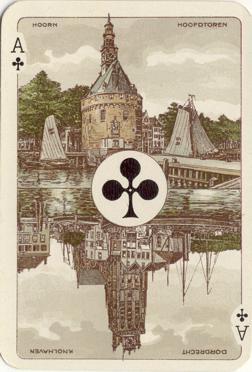The
worldwide recession is beginning to be felt in the Netherlands too. From 1930 to
1940 the playing card department and the printing department do not show any
profit. In 1934 the cardboard-shop is also moved to the Haarlemmer Houttuinen.
The building on the Prinseneiland is rented out as a factory for vacuum
cleaners.
|
The "Trianon"
deck was printed in lithography and published in 1927. The court cards
are inspired by the French and Belgian-Genoese pattern, yet there are
enough differences to regard this deck as a non-standard pattern. The
deck comes with a set of aces that show scenes from (ancient) Paris and
Fontainebleau. Captions on the aces are in French, which is unusual, as
the indices on the courts are Dutch. Published by SN and several firms
(for advertising). Production was stopped around 1935. |

|
|

 

|
|
After 1936 this
deck was no longer listed in the pattern books of SN. The last stock was
sold to the Saks company in 1942. |
In
spite of the recession, the Faddegon company still employed 78 people in 1937,
of which 8 were in the playing card department (SN). In 1939 SN had a turnover
of Hfl 46.000 (Hfl = former Dutch
guilders). From 1940 on the turnover is increasing. A
large stock is present, so the company can easily supply the Dutch market in the
first years. Production is soon started for the German market, as the German
playing card manufacturers had to cut back on or stop their production
completely. Thanks to this export 1943 was a booming year. The turnover is Hfl.
214.000. In the later years of the war the inland market could still be
supplied, but the customers were asked to deliver the card themselves. Paper and
card were on ration and hard to get. The factory itself could get just enough
card to produce for the German market. In 1944 there were
still 80 employees, but during the last year of the war production came to a
stop until May 1945.
previous or
next














